Good Day, Good Night
by Margaret Wise Brown, illus. by Loren Long
The collaboration of Margaret Wise Brown's never-before-published text and Loren Long's (Nightsong, Of Thee I Sing) illustrations begins with a double-page spread featuring a familiar-looking bunny watching the sun rise. "When the sun came up the day began./ Who saw the first light of the sun?/ 'I,' said a bunny, 'the only one.'" Atop his hobbit-hole-like burrow, the bunny, in his red-and-white striped shirt and little blue shorts, leans toward the rising sun, the first colors of dawn creeping in around the edges of the illustration.
"Good morning, world!
Hello, daylight
Good day, everyone
Good-bye, night"
Long's rich illustrations show the rabbit neighborhood waking up: one bunny delivers rolled-up copies of the newspaper, the Daily Warren; our red-and-white-clad bunny picks wildflowers bigger than himself; the Harey Dairy milkman makes the rounds; the proprietor of the Bonbunnyrie pastry shop sweeps the area in front of the store.
With every turn of the page, the morning progresses and the sky behind the animals lightens. Leaving the rabbit warren briefly, the reader says hello to a mother bird bringing breakfast to three peeping baby birds and "good day" to bees buzzing out of their hives.
"Good morning to you!
Open your eyes
For every day
Is a new surprise
Go live your day!"
Now full day, the rabbit town bustles with activity: bunnies on bikes and mopeds zip around the streets, young bunnies play soccer and there's even a tired-looking jogger heading up a hill.
Then, as night starts to fall, the background begins to darken. "When the moon came up the night began," and our red-and-white-clad bunny can be seen once again sitting atop the burrow, gazing at the sky, accompanied by his kitten. The next few spreads show the birds and ladybugs bedding down and the adult rabbits returning from work; our bunny is now dressed in his pajamas, getting cozy in a very familiar-looking room. A teddy bear sits on the yellow-and-green rocking chair, the fire blazes in the fireplace and the night peeks through the red windows. On the side table, next to the green bed with the green-and-yellow bedspread, a number of children's books can be seen, including another classic Harper title, The Carrot Seed.
Good Day, Good Night has much for a young reader to discover: mushrooms and flowers are the same size as the bunny inhabitants, two holes are punched in every vehicle roof for the bunny ears, and there are a ton of rabbit puns. There are also plenty of nods to Brown's original Goodnight, Moon. The trim size of the two books is the same, the bunny's room is illustrated in the same color palette as the classic and on one page, a very sleepy bee parent can be seen inside the hive, reading Goodnight, Moon to a very awake young bee.
This year marks the 70th anniversary of Goodnight, Moon, which has sold 32 million copies in various formats worldwide. Good Day, Good Night is being published not as a sequel, but as a companion to this beloved children's book. While Goodnight, Moon is perfectly designed to lull a child to sleep, Good Day, Good Night allows children to wake up with the same things they go to bed with--it is a "good morning" story as much as it is a "goodnight" story.
Loren Long, a New York Times bestselling picture book author, began his career illustrating greeting cards. Since then, he has written and illustrated his own series of picture books (Otis) and illustrated works for many authors, including President Barack Obama, Madonna and, now, children's literature great Margaret Wise Brown. His colorful acrylic illustrations bring vibrant life to Brown's book with bold, bright colors, vast landscapes that narrow down to bustling animal cities and sweetly rendered animal characters.
Long's illustrations also add their own stories to the text, enhancing and expanding Brown's work. The story itself begins on the endpapers--before a single word appears--with the tiniest hint of sunrise coloring the sky above rolling green hills (the same goes for the book's end: a darkened, night sky over those same hills). And, just as the rhyme and rhythm of the text bring about a feeling of comfort due to their similarity to Goodnight, Moon, the illustrations work to give the reader an immediate familiarity with this title. Long's attention to detail and use of the same color palette as Clement Hurd's result in illustrations that will remind the reader of the original book but make the work solely his.
From the title page, featuring our bunny waking up to the first light of day, to the final spread with our bunny cozily tucked into bed, Good Day, Good Night welcomes the reader into the world of the "great green room" and imaginatively expands it into a great big world. --Siân Gaetano




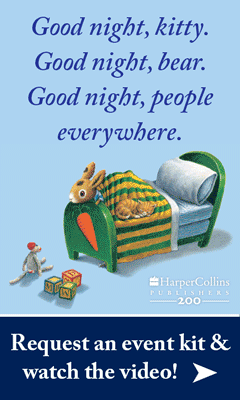
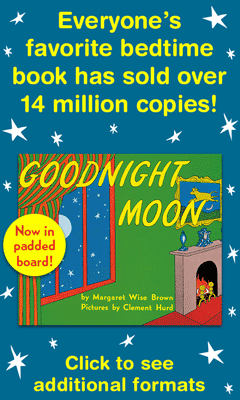
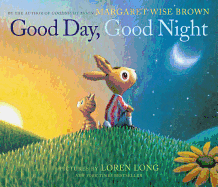


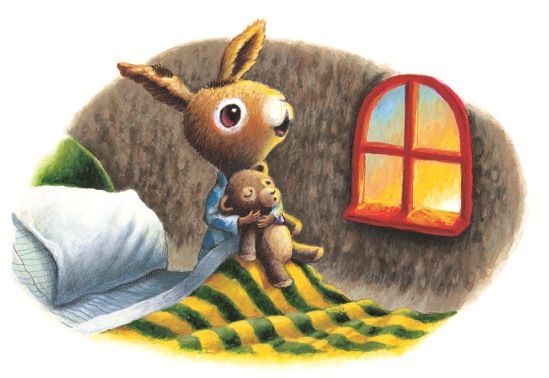 As a young father, I felt very strongly connected to Moon. That connection will never leave me and I believe it will never leave my sons.
As a young father, I felt very strongly connected to Moon. That connection will never leave me and I believe it will never leave my sons. What are some of the creative nods to Night?
What are some of the creative nods to Night?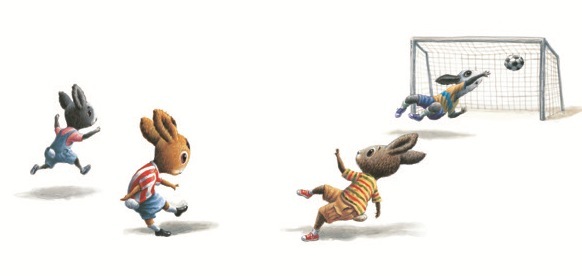 For me, this was kind of a hard text. I started with a little bit of baggage because this is Margaret Wise Brown. I asked myself, "Where does this take place? It talks about a bunny but is that a real bunny?" After asking those questions, I made the choice to break new ground in children's literature and feature a bunny. I thought, "I am going to be brave! I am going to do something that will rock the industry! I'm going to make a bunny book." And I did.
For me, this was kind of a hard text. I started with a little bit of baggage because this is Margaret Wise Brown. I asked myself, "Where does this take place? It talks about a bunny but is that a real bunny?" After asking those questions, I made the choice to break new ground in children's literature and feature a bunny. I thought, "I am going to be brave! I am going to do something that will rock the industry! I'm going to make a bunny book." And I did.